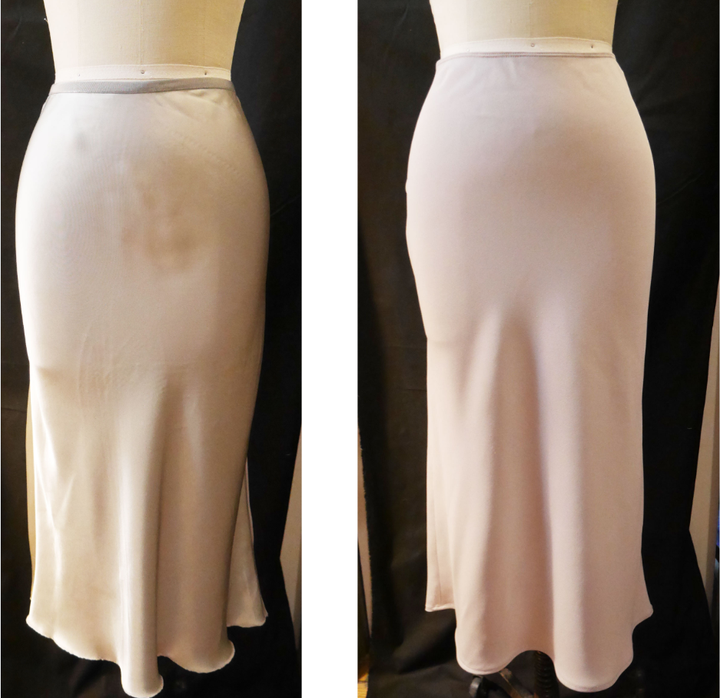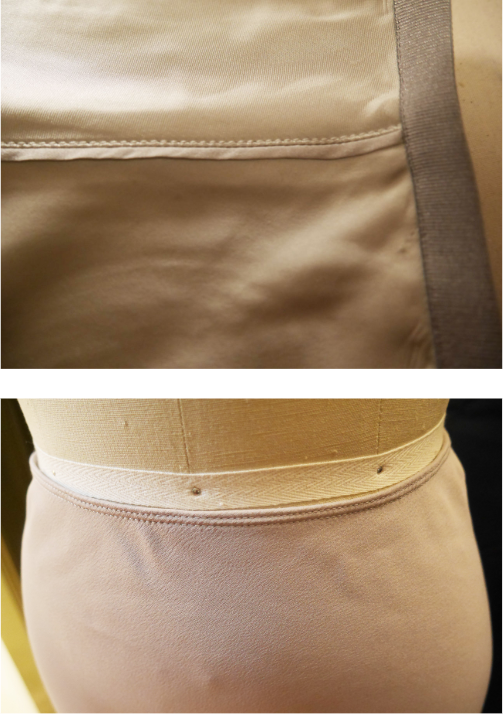Have you ever wondered why designer clothing is so much more expensive than, say, something you’d buy at Topshop or H&M? Some reasons for the price discrepancy can be fairly obvious in the quality of the actual fabric or even in the way a garment is made, but do those things really add up to hundreds of dollars of a difference?
We analyzed a $540 satin midi skirt from Helmut Lang and a $55 satin midi skirt from Topshop to better understand what that extra $495 gets you.
Fabric
One of the most noticeable differences in these two garments is the fabric itself. The Helmut Lang skirt is made from 100% double silk satin (a thicker, heavier fabric than regular satin), whereas the Topshop garment is 100% polyester satin.
While some people think satin means silk, the term actually refers to a type of fabric weave. Satins can be made from silk or polyester or a combination of the two. A satin weave is created by four or more weft yarns over a warp yarn, or four warp yarns over one weft yarn. Warp threads are the vertical threads in a piece of fabric that run the entire length of a fabric bolt, while the weft threads are the cross threads.
Fabrics made from 100% silk cost more per yard than polyester fabrics. Mood Fabrics in New York City, for example, sells polyester satins for $8.99 a yard and silk satins for $59.99 per yard. That’s roughly six times more expensive.
Design Details
The Helmut Lang skirt has some design details that make it more unique than other similar skirts. The skirt’s side seams have an extra decorative edge of fabric visible, similar to piping but without cording inside, providing depth and interest.
The Topshop skirt has plain old seams sewn together with a serged seam (a seam enclosed by multiple threads). At first glance, though, the difference isn’t notable ― you’d have to look closely to appreciate the detail on the Helmut Lang version.

Construction Details
Neither skirt has an actual closure (no zippers, snaps or hooks and eyes). The waistband for the Helmut Lang skirt, though, is made from a thickly woven stretch trim or braid that will likely be more durable than the Topshop version, which simply has elastic that’s attached to the top edge and turned under.

In addition to construction and fabric, there are a few other things that factor into the final price point of a garment.
Garment Manufacturing Costs And Location
Volume is a significant factor in garment manufacturing.
“Anything under 36 pieces is basically considered a sample run,” said Keanan Duffty, program director of MPS Fashion Management at Parsons School of Design. “Sample costs can be 150% to 200% on top of what the actual cost would be once you get into production. So it’s very, very high. Making samples is expensive, and essentially a small run is regarded by a factory as a sample run.”
Cost of fabric works the same way. If you’re buying the whole roll or bolt of fabric, you get one price. If you’re buying anything less than that, you could face a 20% to 30% surcharge.
Then there’s factory location, which is often equated to a perceived higher or lower quality, whether or not this is actually the case.
“If you go to an area like China, the factories are demanding higher volume,” Duffty said. This means it’s more difficult for a niche brand to manufacture there, as they might not be able to meet the minimum number of pieces required by the factory.
Many brands actually make their goods in Eastern Europe or China, but then finish them — e.g. sew the labels in, put the buttons on — in another location. For example, “Prada has been manufacturing shoes in Eastern Europe for a long time, but they finish them in Italy – put the insoles in there and package them and call them ‘Made in Italy,’” Duffty said.
And let’s not forget about another issue that could potentially increase the cost of your garment: fair labor wages. While most clothing brands have implemented procedures and taken steps toward better production practices, surveys conducted by the Clean Clothes Campaign in 2019 show that most labels are still falling short of providing living wages to garment workers in factories that are not in their home countries. One report from Labour Behind The Label found that garment workers in Romania and many other Eastern European companies only earn a sixth of the amount of money that would be considered a living wage in their respective countries.
Brand Identity And Aspirational Products
Brand identity plays a major role in how garments are priced, often more so than fabric choice or manufacturing location or volume.
“You could use the same fabric for a garment at H&M and a garment from an emerging brand or even a premium brand, but the fact that you’re selling in one retail outlet which is perceived at a higher price point as opposed to another lets you really mess around with the perceived value of the garment ― even if the style, production and materials may be the same or similar,” Duffty said.
“Aspirational brand” is a consumer marketing term used to describe a product or brand that the target audience or consumer wishes to own but cannot, for economic reasons. In other words, it’s that $540 Helmut Lang skirt that you can’t quite justify spending that amount of money on.
For instance, consider two white cotton button front shirts with a bit of stretch in them, something like a 97% cotton and 3% Lycra ― one from H&M and one from a perceived premium brand. You could put those two shirts side by side and they would essentially be the same shirt made from the same fabric. It could even be exactly the same fabric.
“Maybe one has real pearl buttons and the other fake, but they look very similar and the stitching is the same. But one you could sell for $35 and the other for $700. That’s brand perception,” Duffty said. The aspirational product probably does have significant design details, like logos or maybe a specific color or a particular kind of button that a discerning consumer would notice, but essentially the two shirts are the same.
Are Designer Price Tags Worth It?
Eric Winterling makes custom costumes for Broadway, film and television. His shop in New York City is responsible for constructing the garments worn by Mrs. Maisel in Amazon’s “The Marvelous Mrs. Maisel.” Winterling has been in the business for 30 years and occupies an entire floor of a small building on West 20th Street in Manhattan.
In his eyes, the value of designer clothing is “absolutely” worth it.
“The thing about designer clothing is that it lasts for more than one season,” Winterling said. In fact, it can last for a lifetime. For example, it’s unlikely that the skirt from Topshop (above) will make it through a single season before one of the seams starts opening up, he said.
There’s nothing wrong with this type of clothing, but it is ephemeral.
As another example, Winterling said he bought a leather jacket from Ralph Lauren ages ago that he still owns today. The zipper broke a couple times and he sent it back to be repaired at Ralph Lauren. When the zipper failed for the third time, he had his own shop fix it. The jacket then spent some years in a closet until one day, Winterling noticed that his partner had packed it up to be sent to Goodwill. He immediately rescued it.
“I can wear that jacket out today, 20-some odd years after I bought it,” Winterling said. And it still looks trendy and fashionable. That’s the biggest difference between the $55 dollar garment and the $500 one: The $500 one is likely something you can wear throughout your lifetime and even pass on to someone else, thus outliving even its original owner. When you look at it that way, $540 isn’t such a bad investment.
